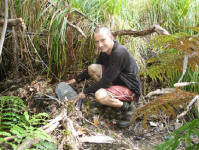Research results and spin-off from community-based conservation projects on Great Barrier.
One of the benefits of having well established conservation sanctuaries such as in the Windy Hill Rosalie Bay Catchment and at Glenfern Sanctuary in Port FitzRoy, is their use for ecological research and the development of pest management efficacy to improve conservation outcomes.
As early as 2002 Auckland University approached both sanctuary areas for permission to have Masters students do their thesis research in them. Deline Semaka completed his Masters thesis on the Effectiveness of Community based Conservation in 2003. He compared the abundance of rats, seedlings, birds, and invertebrates at both Windy Hill and Glenfern with the same species outside these pest managed areas. Although the field work was undertaken over a short time frame, it clearly showed the impact of rats in reducing some native species. At the same time he demonstrated the competence of these community based conservation initiatives. A longer term and more intensive project, with control areas, entitled “To Protect it you have to Measure it” (undertaken by the Windy Hill Rosalie Bay Catchment Trust), now in its second year, further develops Deline’s work. To date it shows markedly more weta, seedlings, and lizards in managed versus unmanaged land. The differences in rat numbers are staggering—for 2007 the average rat monitoring percentage stood at 87% in the unmanaged control site and just 8% in the managed sanctuary.
Two further Masters students, Lucy Davy from Auckland University and Ben Barr from Massey University, are currently doing the field work towards their Masters degrees here. At Windy Hill Lucy is researching the varying types of habitat that rats prefer and at both Glenfern and Windy Hill Ben is researching the impact of rats on chevron skinks. There is much to gain in information and understanding from such input.
In 2007 James Russell won an Auckland University science prize for his research into rats reinvading islands. Part of this research led by Dr. Rachel Fewster involves examining the different genetic pools of rats on Great Barrier and its offshore small islands. The Windy Hill Trust contributed 100 rather grizzly ship rat tails and forepaws towards this research.
Over the last few years the Bay of Plenty Polytechnic Ecology Course have also visited both sanctuary area and students from Auckland University have completed a forest vegetation survey at Glenfern Sanctuary and commenced a similar project at Windy Hill. Also in 2007 members of the Great Barrier Island Charitable Trust presented a paper and a poster about the rat problem on Great Barrier at an international conference in Hawaii. The audience comprised more than 100 scientists from all over the world. We were bombarded with questions and discussion afterwards. The paper will be published in a journal called Biological Invasions.
The economic benefit of these projects to the island are considerable and long-term. The Auckland University projects alone have involved more than 60 students. These young people all enjoy the experience and learn from it, and later pass on the information learned to others. Many return to Great Barrier for holidays, with their friends and families.

